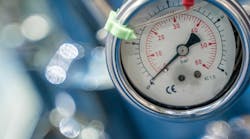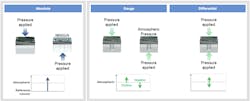Sizing Up Pressure-Sensor Dies and Pressure-Measurement Methods
What you’ll learn:
Highly accurate pressure sensors with long-term stability are necessary for fuel efficiency and reduction of harmful emissions.
Increasingly demanding requirements of piezoresistive sensors include greater sensitivity and high performance with a smaller die size.
The high precision and versatility of piezoresistive sensors to measure absolute, gauge, and differential pressure make them suitable for a host of applications, including many fields in the industrial and automotive sector.
This article shows how pressure sensors fulfill the increasingly demanding requirements of different applications such as tank pressure sensing in plug-in hybrid-electric vehicles (PHEVs) or the growing area of battery electrical vehicles (BEVs). Pressure sensors support battery management and battery cooling fluid, air suspension, vacuum brake boost, transmission, and HVAC systems.
A core component of each pressure sensor is the sensitive element, which converts the pressure into an electrical signal. A wide range of highly accurate, piezoresistive pressure-sensing microelectromechanical-system (MEMS) dies is helpful for this purpose.
Focusing on higher sensitivity and performance in a smaller package, the powerful design features of piezoresistive pressure-sensor dies enhance media resistance, ease of processing, and the ability to provide a reliable signal over their lifetime.
Piezoresistive Principle
The sensing material in a piezoresistive die is a silicon diaphragm, which bends when pressure is applied. This deformation, or mechanical stress, leads to a change in the resistivity of piezoresistors that are implanted within the diaphragm as a resistor bridge configuration (Fig. 1).
Depending on the orientation of the resistors, such a change can either increase or decrease. The bridge circuit then converts this change into an electrical signal, which is proportional to the applied pressure difference.
As one of the early adopters of MEMS technology, piezoresistive pressure sensors are extensively used in the automotive industry to support engine management and safety systems for several good reasons:
- The piezoresistive change in resistance in silicon is based on the interaction of the elastic tension in the material with the special band structure of the semiconductor. As a result, K-factors can be achieved that are 100X greater than in simple metals.
- The measuring element is made of a silicon single crystal. Non-reversible deformations and rearrangements caused by stress are a known effect in polycrystalline materials. Therefore, after stretching a single crystal membrane, the sensor always returns to its original state, without deforming.
- The piezoresistive effect takes place inside of the material bulk. Electrochemical aging of the surfaces, as can occur with capacitive sensors, thus doesn’t influence the effect and sensor performance.
Different Methods of Pressure Sensors
Absolute pressure sensors measure pressure relative to a sealed vacuum reference and thus remain precise and accurate regardless of temperature changes. For a sealed die, the absolute vacuum is created by anodic bonding the silicon to a solid glass base under vacuum condition, either to the front or back side (Fig. 2).
For front-side pressure applications, the medium to be measured gets in direct contact with the active electronics components on the front of the die. This measuring method allows measurements of dry and non-aggressive gases and air.
For measuring the pressure of non-aggressive gases and fluids, such as those involved in fuel or motor-oil applications, contact with the front side must be avoided. Instead, the media enters through an aperture on the backside and the reference vacuum chamber is added onto the front side in the form of a glass cap.
A differential pressure sensor measures the difference between two applied pressures (Fig. 3). A pressure difference with higher pressure on the front side leads to a positive change of the output signal. If the back-side pressure is higher than the front-side pressure, the output signal change is negative. These sensors are suitable for non-aggressive gases and fluids, such as those involved with filter monitoring or flow control.
As the name suggests, a gauge pressure sensor is used to measure the level or volume of a gas or liquid. It’s a special type of differential pressure sensor, as either the front or the back side is exposed to ambient pressure while the other side is exposed to the media to be measured.
Technical Features
The following technical advances are possible due to flexible configuration in pressure-sensor dies:
- If the reference chamber for absolute measurement is sealed with an atomic bonding, the pressure sensor guarantees a high long-term stability compared to other glass-frit bonding technologies.
- A design can be sealed easily with a back-side absolute pressure sensor because the wafer-level package allows a clear separation between electronics and application fluids or gases.
- Electric shielding can directly be designed into MEMS layer systems to reduce electromagnetic and electrochemical impacts on the die’s performance.
- Optional die back-side metallization for a robust solder joint of a pressure-sensing element and sensor package can enable significant media resistance, combined with high mechanical robustness.
- Newer die designs provide flexibility to create platform products for absolute and relative pressure with minor design changes to the pressure-sensor assembly.



